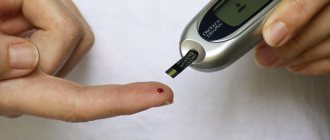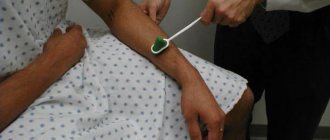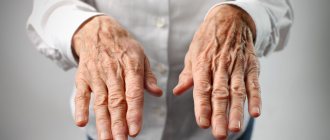- Metabolic agents;
- Analgesics (they can be centrally acting antidepressants and narcotic analgesics);
- Vitamins;
- Preparations to improve blood circulation in nerve fibers;
- Drugs to improve the conductivity of nerve tissue.
Let's take a closer look at all groups of drugs and methods of treating neuropathy.
Polyneuropathy of the extremities of various types (classification of the disease)
Polyneuropathy is divided into 4 main types according to the location of the lesion and the effect on certain fibers and their structures.
Polyneuropathy according to the type of fibers affected. In the human body, fibers are divided among themselves according to their functionality. The disease affecting each group has its own symptoms and signs. Thus, according to their damage, the disease can be divided into:
- a type of disease that affects motor nerve fibers. This species is distinguished by such characteristic features as decreased muscle performance, frequent cramps, failure of the sensitivity of muscle fibers, to complete atrophy;
- a type of disease that affects sensory fibers. Nerve fibers responsible for sensitivity and sensory perception;
- a type of disease that affects vegetative fibers. This species is characterized by disruption of the blood flow system, profuse sweating, impotence and diseases of the genitourinary system;
- mixed type, caused by damage to all types of nerve fibers;
The structure of nerve fibers consists of axons and myelin sheaths. Polyneuropathy can only affect a certain layer in the nerve fiber structure. Thus, according to the nature of damage to fibers, the disease can be divided into:
- The disease, which affects the layer of axons in nerve fibers, lasts quite a long time and manifests itself in atrophy of the limbs. Since it affects to a greater extent the autonomic functions of the limbs;
- a disease that destroys myelin sheaths develops much faster. Pathology manifests itself in disturbances of sensory and motor functions;
Based on the location of the lesions, it is possible to determine such types as distal (the lesions are located in the lower sections) and proximal (the lesions are located in the upper sections).
The type of polyneuropathy can be assessed based on various causes of the disease:
- toxic polyneuropathy. The onset of the disease is provoked by poisoning with antibiotics or other toxic substances (salts, heavy metals, arsenic);
- dismetabolic polyneuropathy. The nature of the occurrence occurs from functional disorders in the nerve fibers. Which occur against the background of the penetration of breakdown products of certain medications into the blood. As a result, there is a violation of metabolic processes that lead to disease;
- alcoholic polyneuropathy. The disease is triggered by the abuse of alcohol and its breakdown products;
- diabetic polyneuropathy. The disease occurs against the background of diabetes mellitus;
Signs of neuropathy
The nature of the clinical picture of hand neuritis varies significantly depending on the stage of development of the disorder and the localization of the pathological process. At first, polyneuropathy is indicated by muscle weakness not associated with physical activity. It is also possible that the skin may become pale, and its color does not always change along the entire length of the affected limb.
Despite the absence of significant discomfort with hand neuropathy at this stage and the symptoms are not so clearly expressed, it is at this time that treatment should begin. Delay in therapy increases the risk of the following complications:
- decreased muscle tone, which impairs motor activity;
- tremors of the limbs;
- reduction or complete absence of sensitivity both in individual areas and along the entire length of the arm;
- drying of the skin;
- muscle spasms;
- intense pain;
- long-term restoration of damaged skin;
- swelling;
- sensations of "goosebumps";
- increased sweating.
In case of damage to the autonomic nervous system, the clinical picture may be supplemented by the following phenomena:
- decreased blood pressure;
- cardiopalmus;
- erectile disfunction;
- impaired motility of the digestive tract;
- breathing disorder;
- impaired pupil reaction.
Over time, the symptoms of neuropathy are accompanied by signs of brain damage, which manifests itself in the form of impaired coordination of movement, loss of space, and frequent dizziness. In advanced cases, due to impaired innervation of the upper extremities, the muscles completely atrophy.
Causes of polyneuropathy of the extremities
Despite the fact that different types of polyneuropathy are caused by different causes, the main reasons for the development of pathology include:
- Immune system dysfunction. A special pathology of immunity appears, in which immune cells devour each other, damaging immune nerve fibers;
- genetic abnormalities and other congenital factors, including hereditary ones;
- metabolic disease. For example, a disorder of blood sugar metabolism in diabetes mellitus, or a disorder of the metabolism of protein products in the blood in uremia;
- poisoning by chemicals and their breakdown products;
- bacterial and viral infections, concomitant damage to the immune and nervous systems in the body;
- various tumors;
- systemic diseases, expressed by disorders in connective tissues and blood vessels;
- avitaminosis;
- hormonal disorders in the functioning of the glands;
- diseases of the genitourinary system;
- liver and gallbladder disease;
Etiology
This disorder can develop from exposure to various factors:
- genetic predisposition;
- immunity disorders, when the body begins to attack its own muscles and nerve fibers, producing immune antibodies;
- diabetes mellitus;
- intoxication with chemical elements, drugs or alcoholic beverages;
- infectious processes of the body, for example, with HIV or diphtheria;
- malignant neoplasms;
- systemic diseases, including scleroderma and vasculitis;
- lack of B vitamins in the body;
- liver cirrhosis;
- autoimmune diseases, for example, Guillain-Barre syndrome.
Symptoms and manifestations of the disease
Polyneuropathy of the upper and lower extremities, according to symptoms and manifestations, can be divided into primary, when the symptoms and lesions are sensitive, and more severe secondary, which is caused by impaired functioning of the nervous system of the extremities. Symptoms and signs expressing the disease:
- tremor of the limbs. It can be constant, periodic and appear under certain circumstances;
- cramps and spasms with painful sensations in the muscles of the upper and lower extremities;
- twitching. Which occur due to involuntary muscle contraction (fasciculation);
- goosebumps and a feeling of trembling on the skin;
- sudden jumps in blood pressure in the arteries. Such symptoms occur when the nerve fibers responsible for the functioning of blood vessels and cardiac functions are damaged;
- sudden increase in heart rate;
- decreased performance of muscle fibers. As a rule, weakness develops initially in the outermost muscles of the limbs, fingers and heels;
- decreased muscle tone;
- complete muscle atrophy;
- atrophy of the sensitivity of the skin;
- loss of orientation in space during sharp turns, climbs, walking blindfolded and disruptions in the sense of balance;
- oxygen starvation of the brain. As a result, dark circles and spots before the eyes, dizziness, darkening of the eyes. These signs appear especially often when suddenly rising from a lying position;
- constant value of heart rate, pulse;
- dry skin;
- gastrointestinal disturbances, such as constipation;
- swelling of the legs;
- feeling of stabbing pain;
Distal axonal polyneuropathy
At the initial stages of the pathological process, distal polyneuropathy of the lower extremities is manifested by the fact that the patient constantly feels cold in the feet. then periodic stabbing pains and a feeling that the leg has served time begin to appear. After a little physical warm-up, all these unpleasant sensations disappear without a trace. However, the attack soon recurs with increasing intensity of clinical symptoms.
Axonal polyneuropathy of the lower extremities, unlike demyelinating polyneuropathy, affects the core of the nerve. The course of the disease is characterized by slow, constant development. If timely treatment is not started, complete immobility quickly sets in.
Diagnosis of the disease
At the first signs of illness, you should immediately consult a doctor. Your attending physician will assess your general condition and, if necessary, prescribe diagnostic tests to determine polyneuropathy of the upper and lower extremities. Diagnosis of the disease consists of:
- studying the patient’s complaints and his existing diseases in the anamnesis;
- consideration of the fact of drinking alcohol in excessive quantities. Alcohol abuse;
- interviewing the patient, establishing his place of work and excluding contact with chemicals;
- the patient has diseases that manifest themselves in changes in the metabolism of sugar and protein products in the blood;
- hereditary factor. Does the patient have relatives with this disease;
- general blood analysis;
- blood test for glucose and protein products;
- blood test for toxic substances;
- nerve fiber biopsy;
- electroneuromyography. Diagnosis of the depth of nerve fiber damage;
- consultation of narrow specialists in the field of endocrinology and therapy;
- ultrasound diagnostics of internal organs;
- x-ray examination;
- analysis of cerebrospinal material;
- reflex study;
- checking the speed of nervous reactions;
- identification of concomitant somatic symptoms;
- palpation of nerve trunks;
- additional methods at the discretion of the doctor;
Treatment of polyneuropathy of the upper and lower extremities
Treatment of a disease that affects the nervous system fibers is a complex process. Including several types of treatment and procedures. The first step on the path to recovery is to identify the main primary diseases, which resulted in polyneuropathy. The entire complex of primary procedures and courses should be aimed at eliminating the primary causes of the disease. In order to prevent its further repetition.
Drug therapy is prescribed taking into account the course of the disease and consists of taking the following drugs:
- methylprednisolone. Glucocorticoid drug;
- analgin and tramadol, to relieve severe pain;
- drugs that suppress immune processes;
- potassium salts, vitamin B, vitamin C;
- protein diet;
- antihistamines (tavegil, suprastin, zodak);
- drugs that improve blood circulation;
- drugs that improve muscle-nervous patency (prozerin);
- mildronate and piracetam. To improve the nutrition of nerve fibers;
- the use of blood purifying drugs for alcoholic and toxic polyneuropathy;
- antidepressants in the treatment of pain syndrome;
- fast sodium channel blockers for analgesic effect;
- pain relief with courses of gabapentin;
- anticonvulsants;
In addition to drug therapy, physiotherapeutic procedures are widely used in courses aimed at treating polyneuropathy. Physical procedures are usually used to consolidate the results of treatment or in its residual stages. Physiotherapeutic methods used in the courses:
- massotherapy;
- magnetic effect on the periphery of nerve fibers;
- the use of electrical devices to directly stimulate nerve fibers;
- indirect massage of internal organs;
To maintain the tone of muscle fibers and support their performance, the patient is prescribed constant therapeutic exercises. with a special course of procedures. The doctor calculates the required physical activity and the necessary set of exercises.
Self-medication and making a diagnosis for such a disease is an extremely dangerous activity. All complexes must be prescribed by a doctor and carried out under his supervision.
Review of drugs
Each group of drugs has its own characteristics, each of them is designed to achieve a specific effect, and together they completely restore nerve fibers and skin sensitivity.
Article on the topic: Find out why the joints of the hand hurt
Physiotherapy perfectly complements medication therapy.
Metabolic agents
These medications are most often used for polyneuropathy of any origin. They have a wide spectrum of action - from metabolic to nerve fiber restoration.
When prescribing, only one drug is selected, and most often it is consistent with the underlying disease that gave rise to polyneuropathy.
Berlition or Octolipen
are most often prescribed - these are derivatives of thioctic acid. It not only has a metabolic effect, but also inhibits oxidative processes that occur under the influence of free radicals. By doing this, it preserves the integrity of the tissues and restores the nerve sheaths. Since this substance also reduces cholesterol levels in the blood, it has a beneficial effect on the entire cardiovascular system. An ideal medicine for diabetes mellitus in combination with atherosclerosis. The drug is taken for a long time, at least one month. The effect is cumulative and may not be noticeable from the first dose. Contraindications will be: pregnancy, allergic reactions, age under 18 years, breastfeeding. The price starts from 350 rubles, depending on the manufacturer. Domestic drugs are cheaper.
Actovegin is an extract from the blood of young calves. The necessary serum components are taken. The drug has a complex effect and nourishes not only the nervous tissue of the peripheral parts of the body, but also the brain. Perfectly helps with polyneuropathy caused by atherosclerosis. Contraindications will be: individual intolerance, pulmonary edema, edema, age under 18 years. The price depends on the release form. Range from 500 to 1500 rubles.
Cerebrolysin is a protein fraction obtained from pig brain. A very strong and effective drug that acts directly on the nervous tissue: improves its trophism and promotes self-healing. It is most often used for alcoholic polyneuropathy. Contraindications: acute renal failure, epilepsy, hypersensitivity to the components of the drug. Price from 1500 rubles, available in ampoules.
Antioxidants
Antioxidants act on nerve tissue at the membrane level. By binding free radicals (elements that destroy cell membranes), they prevent membrane destruction and increase the natural period of self-healing.
This is a very important part of therapy - restoring the integrity of membrane cells, because it is through the cell membranes that the nerve impulse is transmitted.
The course of antioxidants is always long-term (about 1.5-2 months) and must be carried out strictly according to the scheme. This makes it possible to exclude the development of relapse in the future.
Antioxidant drugs include:
Mexidol (Mexiprim - a domestic analogue) is a pure antioxidant agent that also has metabolic activity to some extent. Its additional effect is considered to increase the stress resistance of nerve cell membranes to adverse environmental factors. Contraindications to the medicine: acute conditions of the liver and kidneys, individual intolerance. The price depends on the form of release (tablets and ampoules) - from 400 rubles.
Cytoflavin – has antioxidant activity, increases the stress resistance of the nerve cell and, even in conditions of nutritional deficiency, maintains internal energy reserves at the proper level. Contraindications: age under 18 years, allergic reactions to the components of the drug. Price from 400 rubles.
Pentoxifylline (Agapurin, Vazonit, Trental) - the mechanism of action of the drug lies in its ability to dilate the smallest vessels of the body and, due to this effect, increase their blood supply. The blood flow carries an abundance of nutrients and restores integrity to the membrane membranes. Contraindications: acute myocardial infarction, porphyria, ocular hemorrhages, pregnancy, lactation, hemorrhagic stroke. Price from 50 rubles (for Russian analogues).
Vitamins
A course of vitamins is an integral part of the treatment of lesions of the lower extremities. B vitamins are used (B1, B6, B12), they are responsible for the nutrition of nerve fibers, their conductivity and nutrition. Even a simple lack of these substances in the daily diet can already cause all the symptoms of neuropathy.
For example, tingling in the leg muscles.
The doctor first of all analyzes this parameter and, when diagnosing, first of all tries to exclude vitamin deficiency.
B vitamins play the role of auxiliary therapy, enhancing the effects of the main drugs. The most commonly used:
Combilipen is a complex drug that contains B vitamins and ascorbic acid + lidocaine. The course is prescribed for 10 days. Contraindications: intolerance to components, cardiovascular failure, pregnancy and breastfeeding. Price from 300 rubles for 10 ampoules.
Compligam B is another analogue of Kombilipen, it has similar properties and contraindications. The price is slightly lower - from 250 rubles. Neuromultivit is a medicine for people who are allergic to lidocaine. The composition is completely identical to Kombilipen, with the exception of lidocaine. Contraindications: pregnancy, breastfeeding, childhood, cardiovascular failure. Price from 350 rubles.
Milgamma is an imported analogue of Kombilipen.
Price from 380 rubles. Article on the topic: We provide instructions for using the drug Mataren Plus
Painkillers
For polyneuropathy, different groups of drugs are used as painkillers.
This is due to the fact that conventional analgesics are powerless in this case, because problems of a central nature associated with the nervous system arise.
The following groups of drugs are used for pain relief:
- Narcotic analgesics;
- Antidepressants;
- Anticonvulsants;
- Local remedies.
Let's take a closer look at these groups with examples.
Narcotic analgesics
Tramadol is most often prescribed . It has a powerful analgesic effect and is used for advanced forms of polyneuropathy, which are accompanied by severe pain. The drug is also used in oncology due to its good tolerability and high activity.
Contraindications: combined use with alcohol, age under 1 year, individual intolerance. Price from 150 rubles.
Antidepressants
In addition to the fact that these drugs have analgesic activity, they also improve the patient’s mood. But this effect is secondary.
The value of antidepressants in the treatment of polyneuropathy is their analgesic effect on the central parts of the nervous system.
The following drugs are used:
Amitriptyline – increases the reuptake of serotonin (the hormone of joy), improves mood and stress resistance in general. Has a central analgesic effect. Contraindications: myocardial infarction, glaucoma, acute intoxication, breastfeeding, asthma, manic-depressive psychosis, alcoholism, hypertension (intraocular). Price from 30 rub.
Duloxetine – increases the threshold of pain sensitivity in the brain. Contraindications: angle-closure glaucoma, combination with MAO inhibitors (monoamine oxidase), allergies, renal failure, hypertension, breastfeeding, age under 18 years. Price from 1800 rubles.
Anticonvulsants
They are used in the treatment of neuropathy for two purposes: pain relief and elimination of involuntary contractions of different parts of the legs (trembling).
Sometimes they completely replace other painkillers due to their high activity.
The most commonly used drugs are:
Pregabalin (Lyrica) is an analogue of a natural brain neurotransmitter that eliminates excessive activity of nerve fibers and involuntary contractions. Contraindications: galactose intolerance, hypersensitivity to the components of the drug, age under 17 years. Price from 3000 rubles.
Finlepsin - similarly reduces the activity of nerve impulses in the cells of the central nervous system. Contraindications: bone marrow diseases, atrioventricular block, porphyria, lithium intake, individual intolerance. Price from 300 rubles. Gabapentin is an analogue of Pregabalin with a slightly different structure. Contraindications: pancreatitis, allergic reactions, galactose intolerance, age under 3 years, pregnancy. Price from 300 rub.
Local remedies
In order to achieve the desired effect when treating pathology, you should influence the problem both from the inside and from the outside. For polyneuropathy, ointments and creams that have a warming effect are used externally.
They instantly improve blood circulation and eliminate pain.
The basis of ointments is most often capsaicin - this is an extract from red pepper, it is included in such ointments as:
- Capsicam;
- Arthrocin;
- Hell's root, etc.
Capsicam contains more active substance than ointments that are produced in the form of dietary supplements, so it is better to buy it.
But in any case, you need to consult a doctor.
Improving the conduction of nerve impulses
Deterioration in the conduction of nerve impulses is characterized by:
- Complete or partial loss of skin sensitivity at the site of the lesion;
- Muscular atrophy.
When these symptoms occur, the doctor resorts to prescribing drugs - anticholinesterase drugs. They enhance neuromuscular conduction. Some time after starting to take them, sensitivity returns and muscle strength increases, and the “cotton leg” syndrome goes away. The following medications are used:
Neuromidin is an anticholinesterase agent that improves neuromuscular conduction.
Available in ampoules and administered in courses of 10 days. Contraindications: epilepsy, vestibular disorders, angina pectoris and acute cardiac conditions, asthma, bradycardia, intestinal and bladder obstruction, gastric and duodenal ulcers, pregnancy, lactation, children under 18 years of age, allergies. Price from 1600 rubles for 10 ampoules. Aksamon, Amiridin, Ipigrix are all cheaper domestic analogues of Neuromidin.
Complications after polyneuropathy and prognosis for cure
Polyneuropathy, like all diseases of the nervous system, has consequences. The most common is the complete loss of the ability to move independently. This outcome occurs due to the neglect of various forms of the disease, which led to complete atrophy of muscle fibers in the limbs. And their complete exhaustion. In no case should polyneuropathy be left unattended and the start of the treatment course delayed.
Disease prevention
Polyneuropathy is a rather serious disease that everyone would like to avoid if possible. To ensure that a neurological disease does not affect you, you need to follow and adhere to a number of simple rules:
- exclude the consumption of alcoholic and low-alcohol drinks;
- When interacting and coming into contact with chemicals, use protective equipment and take cleaning agents;
- eating natural foods. Avoid eating foods with a high risk of chemical poisoning;
- Do not take self-prescribed antibiotics and other medications. Take medicine only as strictly prescribed by your doctor;
- promptly begin treatment for viral and bacterial infections. Avoid advanced diseases and consequences;
- take seasonal courses of vitamins that strengthen the immune system;
At the first, even a few, signs of polyneuropathy, immediately consult a doctor for diagnosis and adequate treatment. With timely treatment, you will shorten the rehabilitation period and have every chance of stopping the disease.
Folk remedies for leg polyneuropathy
First of all, it is important to remember that any folk remedy should be introduced into a therapeutic course only with the approval of a doctor. Here are the most commonly used:
- The raw yolk is beaten with olive oil and carrot juice and 2 tablespoons of honey are added to this mixture. Everything is thoroughly mixed and taken orally 2 times a day before meals. The recipe is used for alcoholic polyneuropathy.
- 1 tablespoon of crushed bay leaf is mixed in a thermos with three tablespoons of fenugreek, poured with one liter of freshly boiled hot water and left for 2 hours. Taken in small quantities throughout the day. The recipe is effective for the diabetic form of the disease.
- Brine. Add a glass of salt and 2/3 cup of vinegar to half a bucket of warm water. Steam your feet for 20 minutes every day for a month.
We recommend watching a video about polyneuropathy










